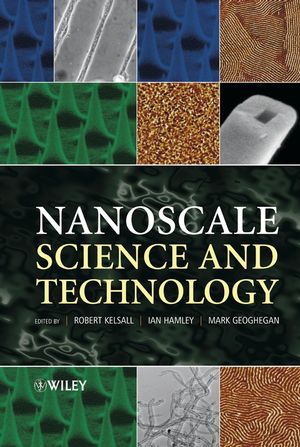Nanoscale Science and TechnologyISBN: 978-0-470-85086-2
Hardcover
472 pages
April 2005
 This is a Print-on-Demand title. It will be printed specifically to fill your order. Please allow an additional 10-15 days delivery time. The book is not returnable.
|
||||||
Preface.
Chapter authors.
1 Generic methodologies for nanotechnology: classification and fabrication.
1.1 Introduction and classification.
1.2 Summary of the electronic properties of atoms and solids.
1.3 Effects of the nanometre length scale.
1.4 Fabrication methods.
1.5 Preparation, safety and storage issues.
Bibliography.
2 Generic methodologies for nanotechnology: characterization.
2.1 General classification of characterization methods.
2.2 Microscopy techniques.
2.3 Electron microscopy.
2.4 Field ion microscopy.
2.5 Scanning probe techniques.
2.6 Diffraction techniques.
2.7 Spectroscopy techniques.
2.8 Surface analysis and depth profiling.
2.9 Summary of techniques for property measurement.
Bibliography.
3 Inorganic semiconductor nanostructures.
3.1 Introduction.
3.2 Overview of relevant semiconductor physics.
3.3 Quantum confinement in semiconductor nanostructures.
3.4 The electronic density of states.
3.5 Fabrication techniques.
3.6 Physical processes in semiconductor nanostructures.
3.7 The characterisation of semiconductor nanostructures.
3.8 Applications of semiconductor nanostructures.
3.9 Summary and outlook.
Bibliography.
4 Nanomagnetic materials and devices.
4.1 Magnetism.
4.2 Nanomagnetic materials.
4.3 Magnetoresistance.
4.4 Probing nanomagnetic materials.
4.5 Nanomagnetism in technology.
4.6 The challenges facing nanomagnetism.
Bibliography.
5 Processing and properties of inorganic nanomaterials.
5.1 Introduction.
5.2 The thermodynamics and kinetics of phase transformations.
5.3 Synthesis methods.
5.4 Structure.
5.5 Microstructural stability.
5.6 Powder consolidation.
5.7 Mechanical properties.
5.8 Ferromagnetic properties.
5.9 Catalytic properties.
5.10 Present and potential applications for nanomaterials.
Bibliography.
6 Electronic and electro-optic molecular materials and devices.
6.1 Concepts and materials.
6.2 Applications and devices.
6.3 Carbon nanotubes.
Appendix: Reference table of organic semiconductors.
Bibliography.
7 Self-assembling nanostructured molecular materials and devices.
7.1 Introduction.
7.2 Building blocks.
7.3 Principles of self-assembly.
7.4 Self-assembly methods to prepare and pattern nanoparticles.
7.5 Templated nanostructures.
7.6 Liquid crystal mesophases.
7.7 Summary and outlook.
Bibliography.
8 Macromolecules at interfaces and structured organic films.
8.1 Macromolecules at interfaces.
8.2 The principles of interface science.
8.3 The analysis of wet interfaces.
8.4 Modifying interfaces.
8.5 Making thin organic films.
8.6 Surface effects on phase separation.
8.7 Nanopatterning surfaces by self-assembly.
8.8 Practical nanoscale devices exploiting macromolecules at interfaces.
Bibliography.
9 Bionanotechnology.
9.1 New tools for investigating biological systems.
9.2 Biomimetic nanotechnology.
9.3 Conclusions.
Bibliography.
Index.



